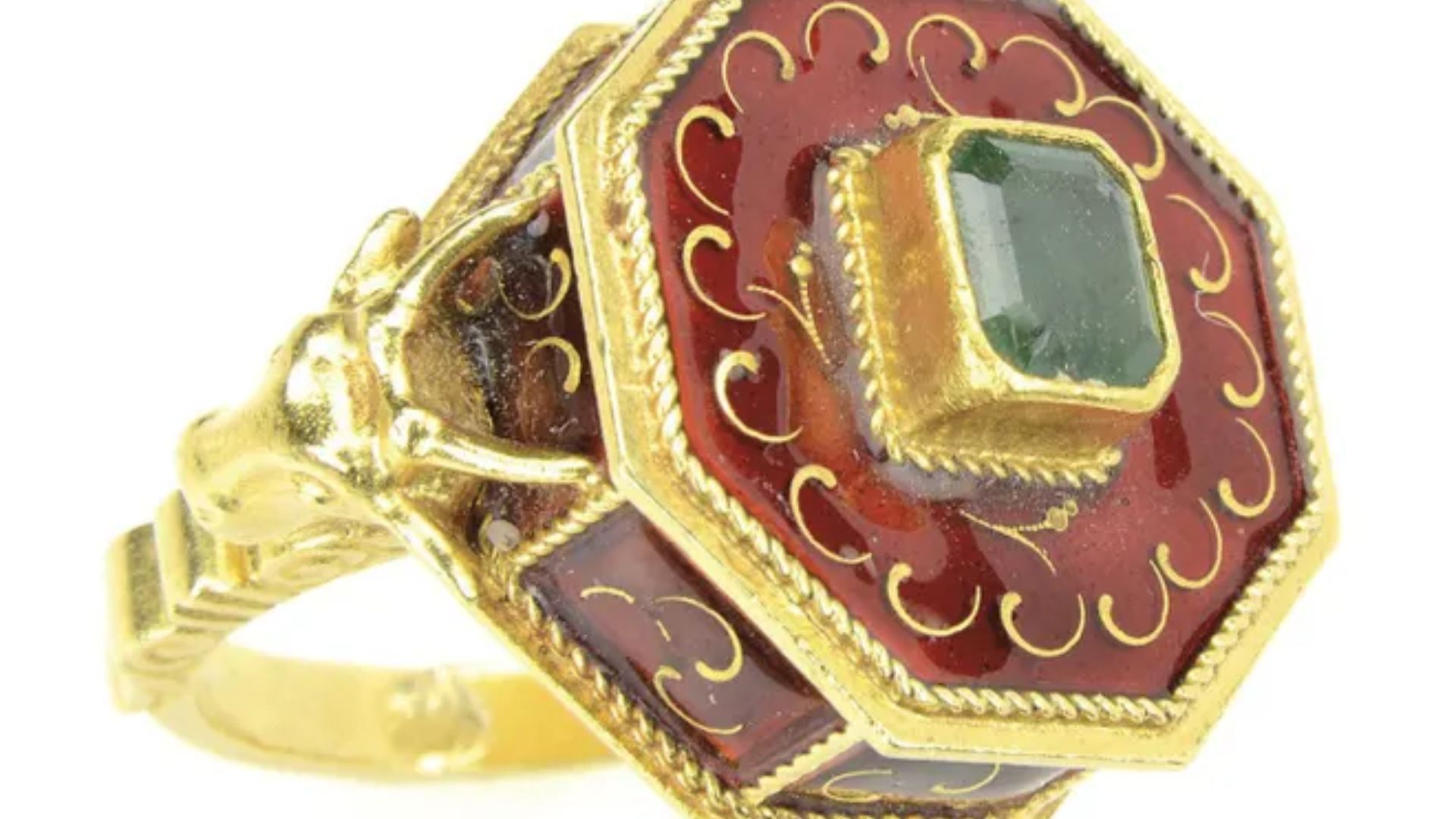Poison rings, also known as locket ringsor compartment rings, are a type of jewelrythat has a dark and intriguing history.
These rings, which have been used throughout various cultures and time periods, are designed with a hidden compartment that can hold a small amount of poison or other substances.
The concept of poison rings dates back centuries, and they have been associated with secrecy, espionage, and even murder. In this article, we will explore the fascinating history, design, uses, and controversies surrounding poison rings.
The Origins And History Of Poison Rings
The concept of poison rings can be traced back to ancient times, with evidence of similar jewelry found in various civilizations such as ancient Rome, India, and China.
These rings were often worn by high-ranking officials, royalty, and individuals who were involved in espionage or other clandestine activities.
The hidden compartment in the ringcould hold a small amount of poison, which could be used as a weapon or for self-defense in case of an emergency.
One of the earliest references to poison rings dates back to ancient Rome, where they were known as "memento mori" rings, meaning "remember that you must die."
These rings were often worn as a reminder of mortality and were believed to protect the wearer from evil spirits. In India, poison rings were known as "nose rings" and were worn by women as a form of self-defense against potential attackers.
It is believed that poison rings were initially used for practical purposes, such as carrying small amounts of perfume, herbs, or religious relics.
However, over time, their use evolved to include more nefarious purposes, such as carrying poison for assassination or self-defense.
Poison rings were often associated with espionage, political intrigue, and covert operations due to their discreet nature and ability to conceal toxic substances.
During the Renaissance period, poison rings gained popularity among the nobility and aristocracy in Europe.
They were often used as a means of political intrigue, allowing individuals to secretly poison their enemies or rivals.
These rings were highly prized for their clever and discreet design, which allowed the wearer to administer poison without arousing suspicion.
The Design And Construction Of Poison Rings
Poison rings are typically designed with a hidden compartment that can be opened to reveal a small compartment for storing poison or other substances.
The compartment is often located on the bezel or the back of the ring and can be opened by a hinge or a sliding mechanism.
The design of poison rings can vary greatly, ranging from simple and utilitarian to intricate and ornate, depending on the culture and time period in which they were made.
Some poison rings feature a single compartment, while others may have multiple compartments for storing different substances.
The compartments are usually small and capable of holding only a small amount of poison, which could be administered by pricking the skin or mixing it with food or drink.
In some cases, the compartment may also contain a small sponge or cloth soaked with poison, which could be used to apply the poison to a weapon or other surfaces.
The construction of poison rings requires skillful craftsmanship, as the hidden compartment must be well-concealed and secure, while still allowing for easy access by the wearer.
The hinge or sliding mechanism must be discreet and durable, ensuring that the compartment remains closed until intentionally opened.
Poison rings may be made from various materials, including precious metals such as goldand silver, as well as gemstones, enamel, and other decorative elements.
Embellishments such as enamel, enamel painting, or inlaid gemstones were also commonly used in the design of poison rings.
Enamel added color and depth to the design, while gemstones added sparkle and visual interest.
These embellishments were carefully chosen and meticulously applied to enhance the overall aesthetic of the ring. Motifs and symbols were also important aspects of the design of poison rings.
Many poison rings featured symbolic engravings or motifs that held personal or cultural significance.
For example, poison rings from ancient times may have featured symbols of protection or good luck, while poison rings from different regions or cultures may have incorporated motifs associated with local customs or beliefs.
The Uses And Purposes Of Poison Rings
Poison rings were used for a variety of purposes throughout history, depending on the culture and context in which they were worn. Some of the common uses of poison rings include.
- Self-defense- Poison rings were often used as a form of self-defense, allowing the wearer to administer poison to an attacker or assailant. The poison could be applied to a weapon or mixed with food or drink, allowing the wearer to incapacitate their opponent and escape.
- Espionage and assassination- Poison rings were used by spies, assassins, and other covert operatives to administer poison to their targets without arousing suspicion.
- Collector's Items and Curiosities- In modern times, poison rings have gained popularity as collector's items and curiosities. These unique pieces of jewelry are often sought after by collectors, historians, and enthusiasts who are fascinated by their history, design, and symbolism. Poison rings can be found in antique shops, auctions, and online marketplaces, and they are often considered rare and valuable pieces of jewelry.
- Symbolic and Decorative Purposes- In addition to their practical uses, poison rings have also been used for symbolic and decorative purposes. Poison rings were often worn as symbols of wealth, status, or power, as they were considered luxury items due to their intricate design and craftsmanship. In some cultures, poison rings were reserved for royalty, nobility, or high-ranking officials, as a symbol of their authority and influence.
- Medicinal and Therapeutic Uses- One of the earliest recorded uses of poison rings was for medicinal and therapeutic purposes. In ancient times, poison rings were used to hold small vials or containers that contained herbal remedies, powders, or oils, which were believed to have medicinal properties. The ring would be worn by a person in need of the remedy, allowing them to carry it with them at all times for easy access.

What is a POISON Ring? | Jill Maurer
The Intricate Design Of Poison Rings
The design of poison rings is a testament to the creativity and craftsmanship of jewelry makers throughout history.
These rings are not only functional but also aesthetically appealing, with intricate and clever mechanisms that allow for the hidden compartment to be discreetly concealed.
In this section, we will explore the unique design elements of poison rings.
One of the key design features of poison rings is the hidden compartment, which can be located on the bezel, the back of the ring, or even on the sides.
The compartment is typically small and well-concealed, often requiring a secret mechanism such as a hinge or a sliding mechanism to open.
The compartment may be designed to hold a small vial or container for storing poison, or it may have a sponge or cloth soaked with poison.
The materials used in the construction of poison rings also vary, depending on the time period and culture in which they were made.
In addition to engraving, poison rings were often embellished with other decorative elements, such as enamel, enamel painting, or inlaid gemstones.
Enamel was used to add color and depth to the design, while gemstones were used to add sparkle and visual interest.
These embellishments were carefully chosen and meticulously applied, further enhancing the intricate design of the poison rings.
They can be made from precious metals such as gold, silver, or platinum, or from more common materials such as brass or bronze.
Some poison rings may also feature decorative elements such as gemstones, enamel, or intricate carvings.
People Also Ask
What Are Poison Rings?
Poison rings are rings that have a hidden compartment used to conceal a small amount of poison or other substances.
How Were Poison Rings Used Historically?
Historically, poison rings were used for a variety of purposes, including medicinal practices, self-defense weapons, and espionage.
What Types Of Substances Were Concealed In Poison Rings?
Poison rings were known to hold various substances such as venom from poisonous animals, toxic plants, or other lethal substances.
Did Poison Rings Have Any Other Uses Besides Carrying Poison?
Yes, besides carrying poison, poison rings were also used for storing small objects such as mementos, herbs, or even tiny keepsakes.
Are Poison Rings Still Used Today?
While the use of poison rings for their original purpose is rare in modern times, they continue to be valued as collectibles and cherished for their historical significance and unique craftsmanship.
Conclusion
Poison rings have a fascinating history and have been utilized for a wide range of purposes over the years. From their early use in medicinal and therapeutic practices to their infamous role in espionage and concealment, poison rings have played a significant role in different cultures and time periods.
They have been used for self-defense, protection, and even as collector's items due to their unique design and historical significance. Whether seen as practical tools, symbols of wealth and status, or as intriguing curiosities, poison rings continue to capture the imagination of people today.
